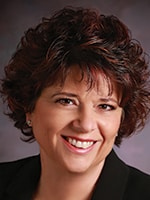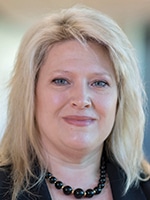October 2022—Who’s doing what with instruments purchased at the peak of the pandemic? That and next-generation sequencing are what CAP TODAY publisher Bob McGonnagle asked Compass Group members about when they met virtually on Sept. 6.
The Compass Group is an organization of not-for-profit IDN system laboratory leaders who collaborate to identify and share best practices and strategies. Here’s what they said last month.
John Waugh, COVID testing is winding down. What are you doing with the additional molecular devices purchased during the pandemic?
John Waugh, MS, MLS(ASCP), system VP, pathology and laboratory medicine, Henry Ford Health System, Detroit: The largest devices we had were from a company acquired by Qiagen, and those continue to produce COVID test results daily, although at a lower volume. The most versatile instrumentation we’ve used since then are Cepheid units, which we’re repurposing for C. difficile testing at our community hospitals. We’re also doing STD panels on the Hologic Panther systems. And we will do more testing for group B strep and MRSA screening for patients headed for surgery. Right now they’re giving prophylactic antibiotics if MRSA status is unknown, and we’d like to help get patients off that protocol if we can.
Lauren Anthony, what are you doing with excess COVID devices?
Lauren Anthony, MD, system laboratory medical director, Allina Health, Minneapolis: We try to deploy what we already have in the most effective way. It’s been affected by staff shortages because certain methods are more hands-on than others, so the least manual methods are being used preferentially when there is a sudden, unexpected staff shortage and we have to close the more high-throughput station. We’ve been looking at which instruments to de-implement.

McHale
Linda McHale, what are you doing with your instrumentation in the Atrium system?
Linda McHale, MBA, MT(ASCP), assistant VP, core laboratory and integration, Atrium Health, Charlotte, NC: We’re insourcing molecular testing to reduce costs. We invested in a Hamilton for preprocessing and are looking at how we can use it for next-generation sequencing testing.
Are you satisfied with the savings?
Linda McHale (Atrium Health): Yes, and we’ve had a good stream of molecular technologists and others interested in working in our molecular department. The leadership there has done a great job building a culture of teamwork.
Johan Otter, what are you doing with devices? You’ve done a lot of reagent rental so you’re not stuck with capital goods, is that right?Johan Otter, DPT, assistant VP, Scripps Health, San Diego: All are reagent rentals, whether it’s the Roche Liat or Abbott ID Now. We still run 100 to 200 tests a day on those platforms. The main platform in the core lab is Hologic, which we use 400 to 800 times a day; our volume hasn’t gone down. We’re still running a positivity rate of around seven percent.
Clark Day, what’s going on at IU with instrumentation bought to deal with the pandemic?
Clark Day, VP of system laboratory services, Indiana University Health: We built a dedicated testing laboratory to support the NCAA tournament in April 2021, so we’re in the process of consolidating molecular testing into our go-forward molecular lab using a couple of Roche 8800 instruments. Throughout the pandemic we deployed Liats and Cepheids to our regional locations, and those remain there. We haven’t had to repurpose or get rid of instrumentation; we just continue to add flu and other respiratory and molecular testing to those existing platforms.
We’re stable at about 500 tests per day for COVID with less than 10 percent positivity.
Darlene Cloutier at Baystate, are you using the instrumentation you have and repurposing it and perhaps saving on send-outs?
Darlene Cloutier, MSM, MT(ASCP), HP, director of laboratory operations, Baystate Health, Springfield, Mass.: Definitely. We acquired a second Roche 6800 in the midst of the pandemic. We use Hologic Panthers as a secondary platform, and we have Abbott ID Now for point-of-care testing. Most of these platforms use reagent rental agreements, and we’ve had no trouble exceeding the volume commitments on these agreements. We had Cepheid instrumentation in place across our system for use in prior flu seasons and have expanded it so we could perform more rapid COVID testing onsite at the hospitals themselves.
We are still doing 700 to 1,000 tests a day on the various platforms, with a positivity rate of about seven percent. There is concern about what the next flu season will bring layered on top of a higher baseline percent for COVID positivity.
Karen Brownell at Intermountain, if you have all this repurposed instrumentation and testing, does it change your acquisition plans for new instrumentation next year?
Karen Brownell, AVP, laboratory services, Intermountain Healthcare, Salt Lake City: I don’t know that it changes too much for the molecular area. We will bring in more testing that is currently being outsourced. It doesn’t impact our instrument planning in other areas of our laboratory.

Brownell
Julie Hess, in hearing about repurposing and bringing tests back in, how do you square that with the labor shortage?
Julie Hess, VP, laboratory services, AdventHealth, Orlando, Fla.: As we think about how we repurpose instruments against a labor shortage, we could deploy the rapid testing we invested in to our smaller campuses, where they may have sufficient labor. Sometimes that is easier than keeping a test centralized. We’re planning to do this with STI testing and group B strep. That is potentially a small increase in labor at a given campus versus trying to use large platforms.
What does next year look like from a budgeting standpoint? We still have PAMA cuts hanging over our heads.
Julie Hess (AdventHealth): We are all feeling that the budget-planning season we’re going into might be one of the more challenging ones. We want to be strong with operations, but we will need to be creative.
Eric Carbonneau, what’s going on at TriCore?
Eric Carbonneau, MS, MLS(ASCP), chief operating officer, TriCore Reference Laboratories, Albuquerque: Our focus for investment next year is on expanding digital pathology.
We looked at how we can redeploy the Hamiltons that we started using in the laboratory-developed test phase of COVID, so we redeployed those in some of our chemistry and esoteric labs. Now we’re looking at investment in automation in cytogenetics and other prep areas. Where can we automate? Because we don’t have labor. We have staff shortages, contract labor is still an issue, and we are rural, and finding staff to go to rural laboratories is difficult.
In vitro diagnostic companies tell me they’re grappling with labor and staff shortages and dealing with inflation in components that go into devices and test kits, from plastics to electronics. Dwayne Breining, are those affecting your finances at Northwell?
Dwayne Breining, MD, executive director, Northwell Health Laboratories, New York: It’s going to be a tough budget year. The laboratories did great with COVID testing but it looks like it’s going away, although we are a bit fearful of what the flu season can bring. For symptomatic patients, you’ll have to test for flu and COVID, which might bring volume up. But just about everything else in health care has been hit hard by COVID. In some ways our system’s looking to the laboratory to make up some of that gap, so it’s going to be challenging.
Do you have acquisition plans for new technologies next year?
Dr. Breining (Northwell): We’re bringing up NGS, specifically in the solid and liquid tumor oncology sphere. Just about everything we have on the PCR molecular front is reagent rental, so we have tons of equipment around.
We leveled off at about 3,000 COVID tests a day, and we’ve been at seven or eight percent positivity for a long time. We’ve seen COVID spikes occur rapidly in New York, which increases the demand 10 times or even more, so we are happy to have excess capacity because we’re not sure what will happen in this flu season.
Dhobie Wong, what are you doing with the equipment you bought for the pandemic? Are you repurposing it?
Dhobie Wong, MBA, MLS(ASCP), CLS, VP of laboratory services, Sutter Health, Sacramento, Calif.: We’re trying to identify primary and secondary platforms for our COVID and flu testing and additional molecular testing and consolidate that volume to get better pricing from vendors, as opposed to having a large swath of different instrumentation. We have a centralized reference laboratory with multiple molecular instruments—the Aries system, Roche, Cepheid—and we’re trying to identify, by looking at our test menus, which ones we can consolidate to primary platforms. We’re doing the same in the acute space, where we have Cepheid, Liat, Abbott.
 CAP TODAY Pathology/Laboratory Medicine/Laboratory Management
CAP TODAY Pathology/Laboratory Medicine/Laboratory Management
